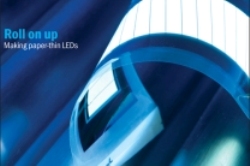Researchers at the Holst Centre in Eindhoven have discovered a new method of producing flexible and thin sheets of organic light-emitting diode (OLED). The researchers, Paul Blom and Ton van Mol, detailed an inexpensive, newspaper-style, “roll-to-roll” printing process.
Traditional "inorganic" LEDs are highly efficient and are being used for a wide range of lighting purposes including traffic lights, car indicators, and display signs. But as they require clean rooms for being fabricated, they are expensive to manufacture. These factors have affected their viability as an alternative to light bulbs.
 Making paper-thin LEDs
Making paper-thin LEDs
OLEDs can be manufactured through a spray-on process, which is more economical and faster when compared to LED production. OLEDs are dissolved in solvents and then sprayed onto rolls of flexible and thin plastic foil. This process is similar to how newspapers are printed. The newspaper-style “roll-to-roll” printing technique enables faster mass production of OLEDs.
The OLED’s bottom layer is made of polymer foils or flexible material. The material contains the electrodes and supports the device. The light-emitting layer is sandwiched over the bottom layer. Both layers have a thickness of around 5 – 200 nm.
For OLED manufacture, the materials have to be deposited with high precision onto the thin film sheet. Each material has different properties and these have to be controlled. Apart from these challenges, it must also be ensured that water does not penetrate the device.
Around 20% of the electricity generated globally is used for lighting purposes and the global energy consumption can be reduced with more efficient lighting technology, where OLEDs can play a major part.
The researchers described their study in the November edition of Physics World.